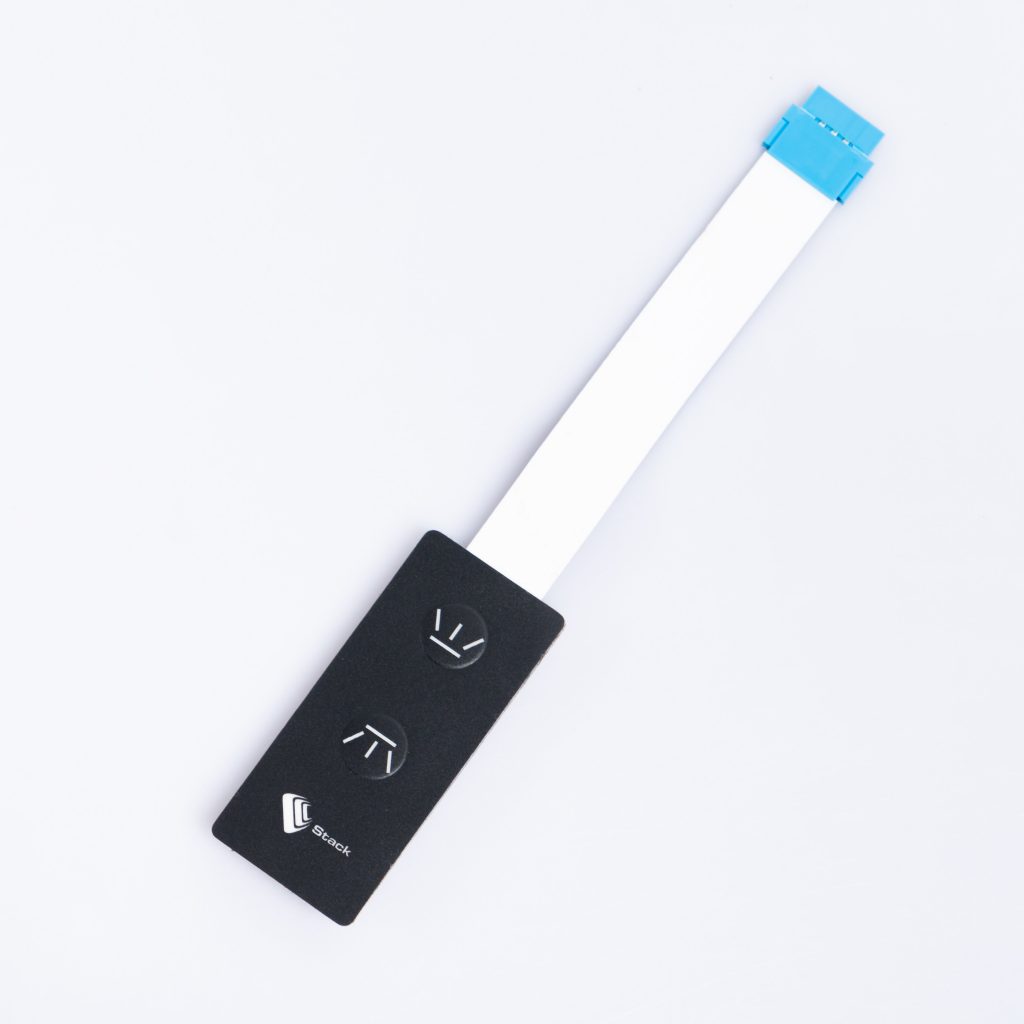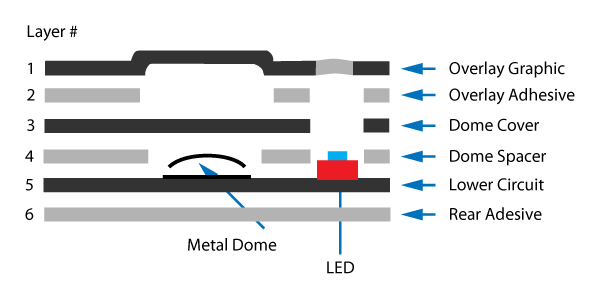The Manufacturing Refine Behind Membrane Switch Over: What You Need to Know
The production process behind membrane layer changes combines cautious style, material option, and quality assurance. It begins with recognizing the complexities of membrane layer switch layout and progresses via various phases, consisting of material selections and printing techniques. Each stage plays a crucial function in making certain functionality and resilience. Nonetheless, the intricacies of layer building and the strenuous screening criteria may disclose insights that are not instantly noticeable. What exists beyond these foundational components?
Understanding Membrane Change Layout
Although membrane layer switches may appear straightforward in the beginning glance, their style includes detailed factors to consider that guarantee functionality and toughness. The style process begins with a thorough understanding of user requirements, including the interface's intended application and environmental factors. Ergonomics is an essential element, as the layout must help with ease of use while ensuring that responsive responses fulfills individual expectations.Moreover, the layering of elements, such as graphic overlays, adhesive layers, and conductive traces, must be specifically crafted. membrane switch. This split configuration not only affects the switch's responsiveness yet likewise affects its durability. Interest is provided to the sealing strategies used to secure against moisture and dirt, which can jeopardize performance. In addition, layout considerations include visual appeals, where color pattern and visual clearness enhance customer experience. Eventually, the design of membrane layer changes balances capability, individual experience, and sturdiness, ensuring that they fulfill the demands of various applications successfully
Materials Made Use Of in Membrane Switch Production
When selecting products for membrane button manufacturing, it is vital to consider both efficiency and sturdiness. The primary materials consist of polyester and polycarbonate films, which give versatility and toughness. These films are usually coated with glue to guarantee correct bonding to substrates. Conductive inks, normally composed of silver or carbon, are important for creating electrical links within the switch, permitting reliable operation.Additionally, a protective layer, such as a tough coat, is often used to enhance scratch resistance and durability. The selection of backing material, such as acrylic or foam, can significantly influence the switch's tactile feeling and total user experience. Various environmental elements, consisting of temperature level and moisture, should guide material choice to ensure peak efficiency in details applications. Inevitably, the right combination of materials adds to the membrane switch's performance and life expectancy, making educated selections crucial for manufacturers.
The Printing Process: Creating Graphics and Text
The printing process in membrane layer button production plays a significant role in producing high-quality graphics and text. Various graphic design strategies are used to assure aesthetic allure and capability, while cautious ink selection approaches are essential for resilience and efficiency. Recognizing these components is basic for attaining best cause membrane switch layout.
Graphic Design Techniques
Graphic layout methods play a vital function in the printing procedure of membrane layer switches, as they specify exactly how graphics and text will inevitably appear on the final item. Effective visuals style involves the critical use typefaces, designs, and shades to improve readability and aesthetic charm. Developers typically utilize vector graphics for scalability, making sure that images stay sharp at various sizes. In addition, interest to comparison and alignment is crucial, as it influences individual communication and aesthetic high quality. The unification of branding aspects, such as logo designs, must be managed with like maintain brand honesty. Overall, thoughtful graphic layout techniques contribute significantly to the capability and beauty of membrane layer buttons, impacting individual experience and item efficiency.
Ink Option Methods
Choosing the proper ink is essential for accomplishing the preferred aesthetic top quality and durability in membrane switch manufacturing. Numerous ink kinds are utilized, including solvent-based, water-based, and UV-curable inks. Each type provides unique features, such as attachment, flexibility, and resistance to ecological variables. Solvent-based inks are often preferred for their durability and vibrant colors, while water-based inks are more environmentally friendly but might have constraints in attachment. UV-curable inks give quick healing and durable performance. Additionally, color matching techniques assure that the picked inks line up with style specs. Ultimately, the choice of ink must take into consideration aspects such as application method, substratum compatibility, and end-use demands to achieve exceptional cause membrane switch graphics and message.
Layer Building And Construction and Assembly

Material Selection Process
A cautious choice of products is crucial in the production procedure of membrane switches, as it directly influences functionality and resilience. The main materials utilized include polyester, polycarbonate, and different conductive inks. Polyester is commonly preferred for its exceptional resistance to chemicals and abrasion, making it ideal for rough settings. Polycarbonate, on the various other hand, gives premium quality and influence resistance, which is valuable for applications calling for presence and toughness. Conductive inks, normally made up of silver or carbon, are crucial for producing reputable electrical pathways. In addition, the selection of sticky materials impacts the overall honesty of the button - membrane switch. Examining elements such as environmental direct exposure, responsive comments, and aesthetic needs overviews producers in selecting the very best products for their certain applications
Layer Adhesion Techniques
Sticking layers in membrane switch building and construction is a crucial process that assures capability and durability. Various bond methods are used to protect perfect bonding in between layers, which normally include the usage of adhesives, warm, and pressure. Pressure-sensitive adhesives (PSAs) are generally used for their convenience of application and instant bonding capabilities. In addition, thermal bonding techniques can be used, where heat is made use of to activate glue residential properties, securing a solid bond. The choice of attachment method mainly depends on the products involved and the certain application requirements of the membrane button. Proper placement and uniform application of adhesives are crucial to stop defects, protecting the button operates successfully throughout its intended life expectancy.
Quality Assurance Actions
Guaranteeing high quality control throughout the layer construction and setting up of membrane switches is essential for maintaining efficiency and integrity. This procedure generally involves numerous critical measures, including complete examinations at each stage of manufacturing. Makers make use of advanced screening methods, such as peel examinations and attachment assessments, to confirm the stability of layer bonds. In addition, aesthetic examinations are conducted to identify any problems in printing or material variances. Ecological problems, such as temperature level and moisture, are very carefully checked to assure excellent curing and attachment. Moreover, regular calibration of equipment helps keep specific production criteria. By implementing these quality assurance actions, suppliers can substantially lower the danger of product failure, guaranteeing that the last membrane layer changes meet the called for requirements and client expectations.
Testing and Top Quality Control Procedures

Innovations in Membrane Layer Change Technology
As advancements in modern technology remain to evolve, membrane layer switches are benefiting from cutting-edge advancements that enhance their capability and individual experience. One notable technology is the assimilation of capacitive touch technology, which enables more user-friendly and receptive customer interfaces. This change not only enhances aesthetic appeals but additionally decreases mechanical damage, prolonging the lifespan of the switches.Additionally, improvements in graphic overlay products have resulted in improved durability and resistance to environmental aspects such as moisture and UV light. These materials now provide improved clearness and brightness, additional raising the visual appeal.Furthermore, the incorporation of clever modern technology is changing membrane switches over right into interactive control panels, enabling connectivity with IoT tools. This connection fosters a smooth customer experience, leading the way for applications in various industries, from health care to consumer electronics. Collectively, these developments position membrane layer switches over as critical components in modern gadget design.
Frequently Asked Questions
How much time Does the Membrane Change Production Refine Take?
The period of the membrane layer button production process can vary significantly. Aspects such as intricacy, products made use of, and manufacturing quantity impact timelines, with typical production ranging from a few days to several weeks for completion.
What Are the Common Applications for Membrane Switches?
Membrane switches are commonly utilized in various industries, including automotive controls, household appliances, medical tools, and customer electronic devices (membrane switch). Their convenience and durability make them perfect for applications requiring user-friendly interfaces and reliable efficiency in varied atmospheres
Can Membrane Changes Be Customized for Specific Demands?

What Is the Life-span of a Typical Membrane Change?
The life-span of a typical membrane switch varies, however normally, it varies from 1 to 5 million cycles. Variables such as use, setting, and material quality significantly influence sturdiness and total efficiency with time.

Are Membrane Switches Eco-friendly?
The ecological friendliness of membrane switches go to this site differs. Some products utilized may not be recyclable, while others can be environmentally friendly. The overall impact relies on making materials and techniques, demanding cautious consideration throughout choice and disposal. The manufacturing process behind membrane layer changes combines careful layout, product selection, and quality control. It starts with comprehending the intricacies of membrane layer switch design and proceeds see this website with various phases, including product choices and printing strategies. When choosing materials for membrane layer switch production, it is vital to contemplate both efficiency and sturdiness. A careful choice of materials is crucial in the manufacturing procedure of membrane buttons, as it directly affects functionality and longevity. The option of attachment technique greatly depends on the materials entailed and the particular application needs of the membrane button.